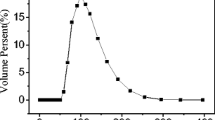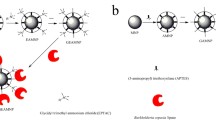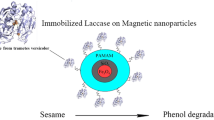Abstract
Candida antarctica lipase B (CALB) was immobilized on Fe3O4/SiOx-g-P (GMA) polymer carrier to obtain nano-magnetic Fe3O4/SiOx-g-P (GMA) lipase (magnetic enzyme). The obtained magnetic enzyme particles had an enzyme protein loading of 98.7 mg/g, an enzyme activity of 1226.5 U/g, an average particle diameter of 100.5 ± 1.30 nm, a magnetization of 15.80 emu/g, a magnetic enzyme optimum pH of 7.0, and an optimum temperature of 50 °C. The prepared magnetic enzyme was used as a catalyst, phytosterol was esterified with free fatty acid (FFA) in rice bran oil (RBO). Under the conditions of pH was 7.0, the FFA/phytosterol molar ratio was 1:4, the dosage of the immobilized CALB was 10.0%, the esterification temperature was 50 °C, the esterification time was 72 h, and the molecular sieve addition was 8.0%. The FFA content in RBO decreased from 16.0 to 2.4%, and the conversion rate of phytosterol was 85.7%. When the magnetic enzyme was used repeatedly for 7 times, the relative enzyme activity of the magnetic enzyme was 83.0%, which improved the utilization efficiency of the enzyme.
Graphic Abstract













Similar content being viewed by others
References
Lavanya MN, Saikiran KCS, Venkatachalapathy N (2019) Stabilization of rice bran milling fractions using microwave heating and its effect on storage. J Food Sci Technol 56:889–895. https://doi.org/10.1007/s13197-018-3550-y
Aryusuk K, Puengtham J, Lilitchan S, Jeyashoke N, Krisnangkura K (2008) Effects of crude rice bran oil components on alkali-refining loss. J Am Oil Chem Soc 85:475–479. https://doi.org/10.1007/s11746-008-1215-0
Habaki H, Hayashi T, Egashira R (2008) Deacidification process of crude inedible plant oil by esterification for biodiesel production. J Environ Chem Eng 6:3054–3060. https://doi.org/10.1016/j.jece.2018.04.039
Wang X, Lu J, Liu H, Jin Q, Wang X (2016) Improved deacidification of high-acid rice bran oil by enzymatic esterification with phytosterol. Process Biochem 5:1496–1502. https://doi.org/10.1016/j.procbio.2016.08.013
Guajardo N, Ahumada K, Domínguez de María P et al (2018) Remarkable stability of Candida antarctica lipase B immobilized via cross-linking aggregates (CLEA) in deep eutectic solvents. Biocatal Biotransformation 37:106–114. https://doi.org/10.1080/10242422.2018.1492567
Kautsari SN, Handayani S, Hudiyono S (2016) Interesterification of palm oil by using immobilized Candida rugosa lipase on Fe3O4-polydopamine nanoparticles. AIP Conf Proc 1729(1):157. https://doi.org/10.1063/1.4946962
Shahzad N, Khan W (2017) Phytosterols as a natural anticancer agent: current status and future perspective. Biomed Pharmacother 88:786–794. https://doi.org/10.1016/j.biopha.2017.01.068
Moreau RA, Nystr ML, Whitaker BD et al (2018) Phytosterols and their derivatives: structural diversity, distribution, metabolism, analysis, and health-promoting uses. Prog Lipid Res 70:35–61. https://doi.org/10.1016/j.plipres.2018.04.001
Li YC, Li CL, Li R (2018) Associations of dietary phytosterols with blood lipid profiles and prevalence of obesity in Chinese adults, a cross-sectional study. Lipids Health Dis 17:54. https://doi.org/10.1186/s12944-018-0703-y
Zheng M-M, Lu Y, Dong L (2012) Immobilization of Candida rugosa lipase on hydrophobic/strong cation-exchange functional silica particles for biocatalytic synthesis of phytosterol esters. Bioresour Technol 115:141–146. https://doi.org/10.1016/j.biortech.2011.11.128
Chawla R, Goel N (2016) Phytosterol and its esters as novel food ingredients: a review. Asian J Dairy Food Res 35:217
Molina-Gutiérrez M, Hakalin NLS, Rodríguez-Sanchez L (2017) Green synthesis of β-sitostanol esters catalyzed by the versatile lipase/sterol esterase from Ophiostoma piceae. Food Chem 221:1458–1465. https://doi.org/10.1016/j.foodchem.2016.11.005
Qianchun D, Pin Z, Qingde H (2011) Chemical synthesis of phytosterol esters of polyunsaturated fatty acids with ideal oxidative stability. Eur J Lipid Sci Technol 113:441–449. https://doi.org/10.1002/ejlt.201000090
Zheng MM, Huang Q, Huang FH et al (2014) Production of novel “functional oil” rich in diglycerides and phytosterol esters with “one-pot” enzymatic transesterification. J Agric Food Chem 62:5142–5148. https://doi.org/10.1021/jf500744n
Zheng MM, Lu Y, Huang FH, Wang L, Guo PM, Feng YQ, Deng QC (2012) Lipase immobilization on hyper-cross-linked polymer-coated silica for biocatalytic synthesis of phytosterol esters with controllable fatty acid composition. J Agric Food Chem 61(1):231–237
Scholz B, Menzel N, Lander V et al (2011) Heating two types of enriched margarine: complementary analysis of phytosteryl/phytostanyl fatty acid esters and phytosterol/phytostanol oxidation products. J Agric Food Chem 64:2699–2708. https://doi.org/10.1021/acs.jafc.6b00617
Xie W, Zang X (2017) Covalent immobilization of lipase onto aminopropyl-functionalized hydroxyapatite-encapsulated-γ-Fe2O3 nanoparticles: a magnetic biocatalyst for interesterification of soybean oil. Food Chem 227:397–403. https://doi.org/10.1016/j.foodchem.2017.01.082
Xie W, Wang J (2012) Immobilized lipase on magnetic chitosan microspheres for transesterification of soybean oil. Biomass Bioenergy 36:373–380. https://doi.org/10.1016/j.biombioe.2011.11.006
Takaç S, Bakkal M (2007) Impressive effect of immobilization conditions on the catalytic activity and enantioselectivity of Candida rugosa, lipase toward S-Naproxen production. Process Biochem 42:1021–1027. https://doi.org/10.1016/j.biombioe.2011.11.006
Tamalampudi S, Talukder MR, Hama S et al (2008) Enzymatic production of biodiesel from Jatropha oil: a comparative study of immobilized-whole cell and commercial lipases as a biocatalyst. Biochem Eng J 39:185–189. https://doi.org/10.1016/j.bej.2007.09.002
Chen SC, Duan KJ (2015) Production of galactooligosaccharides using β-galactosidase immobilized on chitosan-coated magnetic nanoparticles with tris (hydroxymethyl) phosphine as an optional coupling agent. Int J Mol Sci 16:12499–12512. https://doi.org/10.3390/ijms160612499
Yu D, Ma Y, Jiang L et al (2013) Optimization of magnetic immobilized phospholipase A1, degumming process for soybean oil using response surface methodology. Eur Food Res Technol 237:811–817. https://doi.org/10.1007/s00217-013-2057-z
Li H, Cao C, Zhao Y (2011) Hydrodynamic behaviors in gas-solid two-phase magnetic fluidized beds 1. Experimental results represented by a dimensionless number. Chem Eng Technol 34:760–766. https://doi.org/10.1002/ceat.201000411
Yu D, Ma Y, Jiang L et al (2013) Optimization of magnetic immobilized phospholipase A1degumming process for soybean oil using response surface methodology. Eur Food Res Technol 237:811–817. https://doi.org/10.1007/s00217-013-2057-z
Mohammadi M, Habibi Z, Dezvarei S et al (2014) Improvement of the stability and selectivity of Rhizomucor miehei, lipase immobilized on silica nanoparticles: selective hydrolysis of fish oil using immobilized preparations. Process Biochem 49:1314–1323. https://doi.org/10.1016/j.procbio.2014.04.012
Lin L, Bai Y, Li Y et al (2009) Study on immobilization of lipase onto magnetic microspheres with epoxy groups. J Magn Magn Mater 321:252–258. https://doi.org/10.1016/j.jmmm.2008.08.047
Hu L, Llibin S, Li J, Qi L, Zhang X, Yu D (2015) Lipase-catalyzed transesterification of soybean oil and phytosterol in supercritical CO2. Bioprocess Biosyst Eng 38:343–2347. https://doi.org/10.1007/s00449-015-1469-5
Society AOC, Firestone D (1989) Official methods and recommended practices of the American Oil Chemists’Society. AOCS, Champaign
Liu X, Guan Y, Shen R et al (2005) Immobilization of lipase onto micron-size magnetic beads. J Chromatogr B 822:91–97. https://doi.org/10.1016/j.jchromb.2005.06.001
Guzik U, Hupert-Kocurek K, Marchlewicz A et al (2014) Enhancement of biodegradation potential of catechol 1,2-dioxygenase through its immobilization in calcium alginate gel. Electron J Biotechnol 17:83–88. https://doi.org/10.1016/j.ejbt.2014.02.001
Yu D, Zhang X, Zou D et al (2018) Immobilized CALB Catalyzed Transesterification of Soybean Oil and Phytosterol. Food Biophys 13:208–215. https://doi.org/10.1007/s11483-018-9526-7
Sathya K, Saravanathamizhan R, Baskar G (2018) Ultrasound assisted Phytosynthesis of Iron Oxide Nanoparticle. Ultrason Sonochem 39:446–451. https://doi.org/10.1016/j.ultsonch.2017.05.017
Zheng M, Zhu J, Huang F, Xiang X, Shi J et al (2015) Enzymatic deacidification of the rice bran oil and simultaneous preparation of phytosterol estersenriched functional oil catalyzed by immobilized lipase arrays. RSC Adv 5:70073–70079. https://doi.org/10.1039/C5RA11533G
Zeng CX, Qi SJ, Li ZG (2015) Luo RM enzymatic synthesis of phytosterol esters catalyzed by Candida rugosa lipase in water-in-[Bmim]PF6 microemulsion. Bioprocess Biosyst Eng. 38:939–946. https://doi.org/10.1007/s00449-014-1339-6
Takanami T, Hayashi M, Hino F et al (2003) Effect of water content and temperature on Carica papaya lipase catalyzed esterification and transesterification reactions. OCL 10:400–404. https://doi.org/10.1051/ocl.2003.0400
Villeneuve P, Turon F, Caro Y (2005) Lipase-catalyzed synthesis of canola phytosterols oleate sters as cholesterol lowering agents. Enzyme Microb Technol 37:150–155. https://doi.org/10.1016/j.enzmictec.2005.02.002
Esperónrojas AA, Baezajiménez R, Canosarmiento C, García HS (2017) Structured mono- and diacylglycerols with a high content of medium chain fatty acids. J Oleo Sci 66:991–996. https://doi.org/10.5650/jos.ess17010
Gharat N, Rathod VK (2013) Ultrasound assisted enzyme catalyzed transesterification of waste cooking oil with dimethyl carbonate. Ultrason Sonochem 20:900–905. https://doi.org/10.1016/j.molcatb.2012.11.007
Xia GH, Liu W, Jiang XP et al (2013) Surface modification of nanoparticles for immobilization of lipase. J Nanosci Nanotechnol 17:370–376. https://doi.org/10.1166/jnn.2017.10964
Acknowledgements
This work was also supported by a grant from Rice bran high-value steady-state processing technology and intelligent equipment development and demonstration (No.: 2018YFD0401101). Additionally, this work was supported by a grant from the Province Natural Science Foundation of Heilong Jang: Study on the Mechanism of Continuous Orientation Esterification of Nanometer Magnetic Lipase (No.: C2017019). This work was supported by a grant from the National Natural Science Foundation of China (NSFC): Study on the mechanism of nanomagnetic enzyme hydrolysis of soybean oil by multi-effect orientation and biosynthesis of functional lipids (No.: 31571880). The authors would like to thank the anonymous reviewers and the editor for their comments on an earlier version of this paper.
Author information
Authors and Affiliations
Corresponding author
Additional information
Publisher's Note
Springer Nature remains neutral with regard to jurisdictional claims in published maps and institutional affiliations.
Lanxia Qin and Fei Wu provided a lot of academic theoretical guidance and technical support for the article.
Rights and permissions
About this article
Cite this article
Yu, D., Yu, C., Wang, T. et al. Study on the Deacidification of Rice Bran Oil Esterification by Magnetic Immobilized Lipase. Catal Lett 150, 1256–1267 (2020). https://doi.org/10.1007/s10562-019-02939-9
Received:
Accepted:
Published:
Issue Date:
DOI: https://doi.org/10.1007/s10562-019-02939-9




